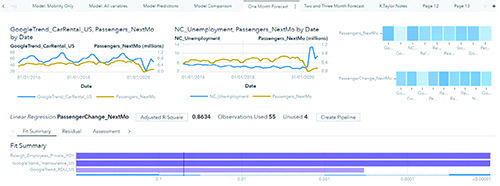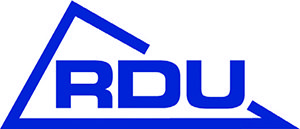Widespread uncertainty was understandable given the unprecedented circumstances presented by the global pandemic. But passenger forecasts impact nearly every area of operations, from parking lot closures and law enforcement schedules to concession hours and capital improvement projects. So Kenneth Strickland pressed on for clearer answers.
When Mike Landguth, president and chief executive officer of Raleigh-Durham International (RDU), entered Kenneth Strickland’s office in early March 2020, he had an important question for the airport’s air service development director: How long would COVID-19 impact airline travel?
 It was the same question airport directors across the globe were asking. And when Strickland turned to trusted industry analysts for answers, he found a distinct lack of consensus.
It was the same question airport directors across the globe were asking. And when Strickland turned to trusted industry analysts for answers, he found a distinct lack of consensus.
“The potential scenarios were all over the map,” recalls Strickland. “You had a lot of experts predicting wildly different things. Aviation consultants were a little more positive than other industries, yet they could not nail down a prediction for recovery.”
Widespread uncertainty was understandable given the unprecedented circumstances presented by the global pandemic. But passenger forecasts impact nearly every area of operations, from parking lot closures and law enforcement schedules to concession hours and capital improvement projects. So Strickland pressed on for clearer answers.
|
Project: Traffic Forecasting Location: Raleigh-Durham (NC) Int’l Airport Data Analytics: SAS Strategy: Research alternative data, such as rental car reservations & tourist attraction hours, to help predict passenger volume Timeline: Ongoing effort began in early May 2020 Results: Enplanement predictions are within 5% of actual traffic Cost: $0 Of Note: SAS provided airport & other local companies pro bono counsel to help them weather business effects of COVID-19 |
Previously, he relied on passenger enplanement numbers, airline capacity and Gross Domestic Product statistics for near-term forecasting. “We could predict our passenger numbers with 98% accuracy based on airlines’ seat capacity because seat capacity dictates demand,” Strickland explains.
But COVID-19 completely changed the standard approach.
When it became clear that traditional strategies would no longer work, Strickland switched gears to a statistical analysis model he remembered from graduate school. The method, meta-analysis, combines findings and predictions from multiple studies and experts to determine an average.
“None of the studies is completely accurate individually, but collectively they will come pretty close,” Strickland explains. Yet, even this broader approach only took the North Carolina airport so far.
“We kept trying to find a solution,” Landguth recalls. And just as RDU executives began to consider consulting banks and other sources for insight, one of the airport’s neighbors reached out to offer help.
Local Partnership
SAS, one of the largest data analytics companies in the world, also happens to be located just minutes away from RDU. So is Research Triangle Park, headquarters for about 300 leading technology and life science companies.
As the impacts of COVID-19 became clearer, SAS leadership directed its specialists to reach out to customers and other local companies to see how the firm’s software could help them navigate COVID-19 from a business standpoint.
“When the pandemic hit, our first thought was that this pretty much invalidates the analytics that businesses are dependent on,” says Anthony Mancuso, global head of risk modeling and decisioning for SAS. “We started reaching out to customers and helping them determine how to proceed.”
David Morgan, the company’s senior transportation advisor and a member of the RDU Airport Authority board, urged Mancuso to contact RDU.

“The first thing we did was meet with RDU and learn about their problem,” recalls Mancuso. “Passenger traffic was completely off the charts in the negative. It was having a lot of implications for derived revenue and staffing. We looked at that and saw the exact same things in financial services.” Predicting the future was difficult, because the situation has changed so much, he adds.
After identifying the parallels between RDU and other SAS clients, Mancuso and his team shared strategies that were working for other businesses.
The first step was to identify alternative data, which is commonly used in the financial services industry. Mancuso explains that if companies and organizations look beyond the values traditionally used to predict future business, their forecasts can become more accurate.
Historically, RDU had focused on variables such as airline schedules and seat capacity, which were not updated frequently. To improve the scope and timeliness of the airport’s data, Mancuso and his team advised Strickland to use Google to search topics such as rental cars and Statue of Liberty hours, which could help indicate when leisure travel was picking up.

“We found that rental car reservations had a strong statistical relationship to travel two weeks into the future,” says Strickland. “Using SAS’ approach and software, we can also create models based on specific assumptions.” These assumptions include vaccination rates and spikes in COVID cases.
By June 2020, Strickland and SAS had developed a model that predicted passenger enplanements within 5% of the actual traffic volume.
New Approach to Passenger Forecasting
Collaborating with its high-profile neighbor didn’t cost RDU a dime. Mancuso explains that SAS simply wanted to help the airport and other community members through the pandemic.
“Our goal was not to sell software”, he remarks. “We gave our time. The edict from my bosses and their bosses was just to help.”
It’s a gesture that will not be forgotten, and will continue to reap benefits for the airport.
“We appreciate SAS’ partnership, which helped us through a very difficult time and a lot of unknowns,” says Landguth. “We are now in a position to know when to build infrastructure for the future.”
Input from SAS has also enhanced communication and interface with airlines operating at RDU.
 “Credibility is key,” emphasizes Strickland. “The decisions airlines make are always based on data. They have to be confident in the information you provide. Our new approach has increased RDU’s reputation for providing accurate data they can rely on.”
“Credibility is key,” emphasizes Strickland. “The decisions airlines make are always based on data. They have to be confident in the information you provide. Our new approach has increased RDU’s reputation for providing accurate data they can rely on.”
Moving forward, the airport plans to continue working with industry consultants who provide insight into airline operations and future planning. However, it also plans to continue researching alternative sources for information to supplement their efforts.
“We now strive to be more data dependent and data smart, because passenger projections have implications for every part of our business,” Strickland concludes.


 facts&figures
facts&figures

